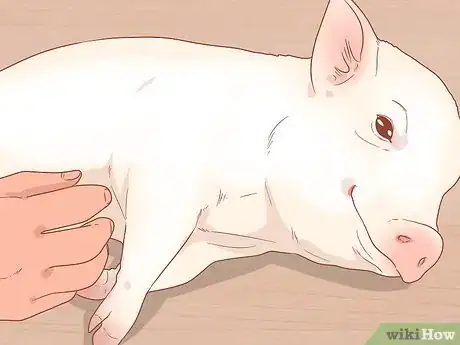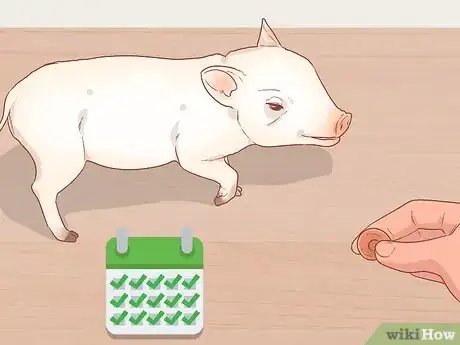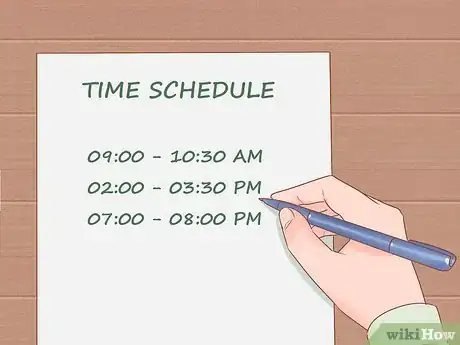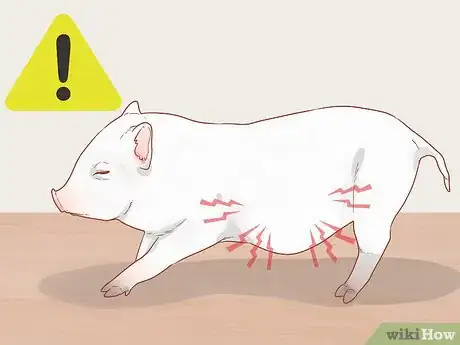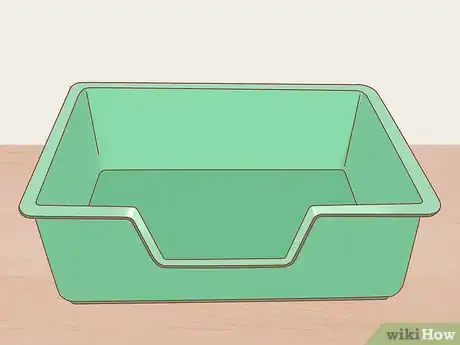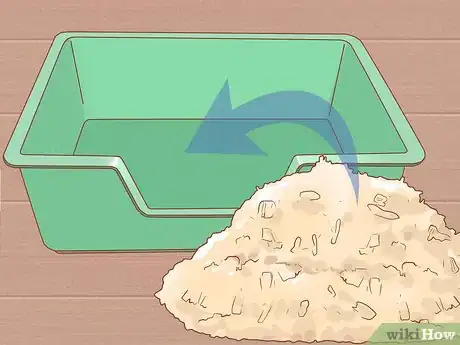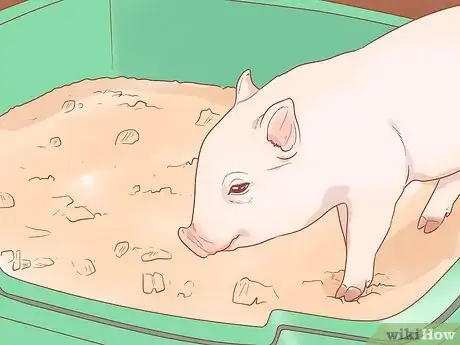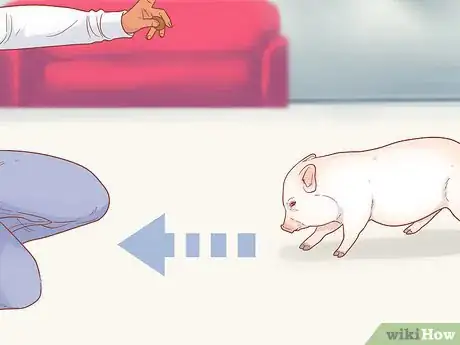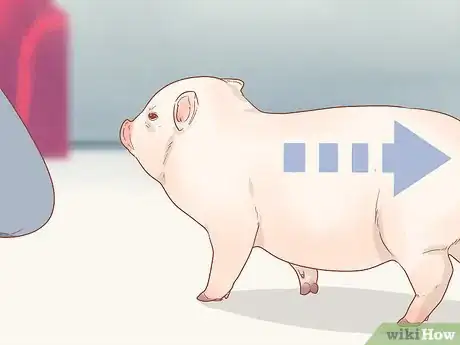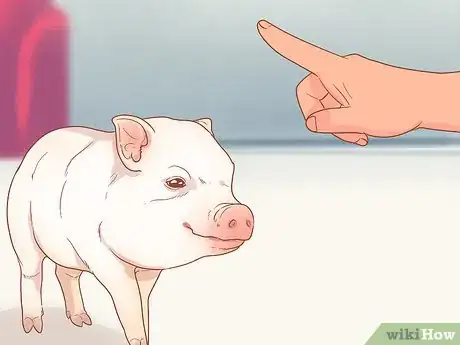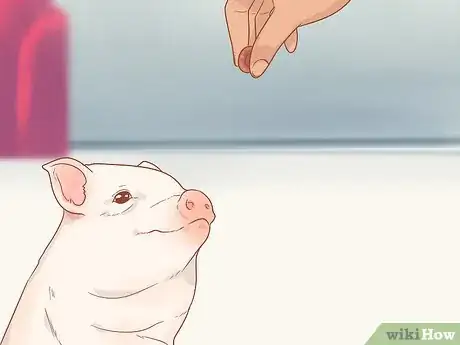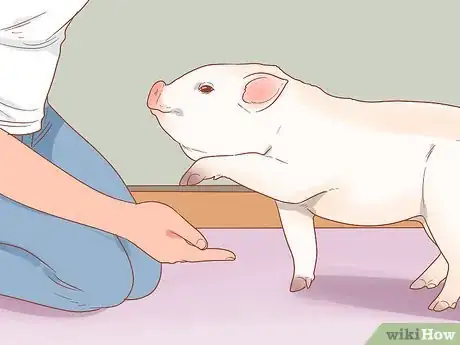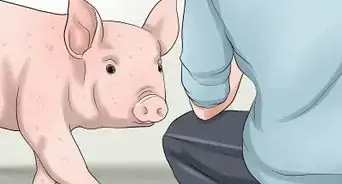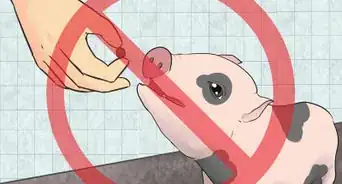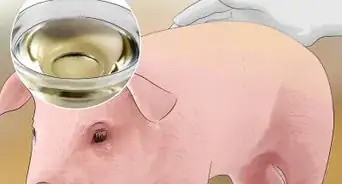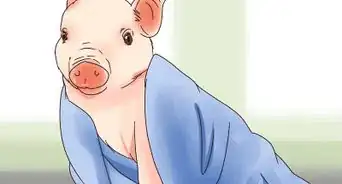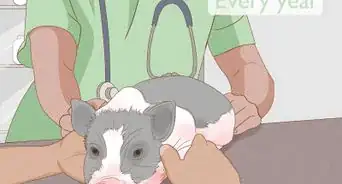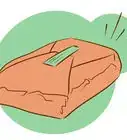This article was co-authored by wikiHow Staff. Our trained team of editors and researchers validate articles for accuracy and comprehensiveness. wikiHow's Content Management Team carefully monitors the work from our editorial staff to ensure that each article is backed by trusted research and meets our high quality standards.
There are 13 references cited in this article, which can be found at the bottom of the page.
This article has been viewed 57,628 times.
Learn more...
Because pigs are highly intelligent and easily motivated by food and affection, they’re surprisingly easy to train. Although pigs aren’t the right pets for everyone, as a responsible pig owner you can establish good behaviors early on with commands like “no,” “stay,” “come,” and “leave it.” You can also house train your pig so it uses a litter box and walks on a leash. With some healthy treats and patience, your pig will be trying to impress you with its mastery of new tricks like “spin,” “sit,” and “shake.”
Steps
Establishing a Training Routine and Rewards
-
1Start training your pig as early as possible. If you begin training your pig when it’s very young, or as soon as you get it, you’ll be able to establish good behaviors. You will keep your pig mentally stimulated and engaged while nurturing a bond between you and your pig.[1]
- Pigs like hierarchical relationships. By training a young piglet, you can establish yourself as the leader of the herd.[2]
-
2Train your pig every day. Like other intelligent animals, pigs become destructive when they’re bored. Prevent boredom from setting in with a consistent routine that your pig can anticipate.[3]
- It is in a pig’s nature to investigate and forage.[4] Balance your training regime with other “free time” activities that allow your pig to safely explore.
Advertisement -
3Set a specific time each day to train your pig. Plan to implement your training program during specific times of the day. Observe your pig’s habits to learn which times of day it has the highest levels of focus and patience. Also consider training your pig just before bedtime, to use up the last bursts of mental and physical energy for a good night’s sleep.[5]
- Pigs function well with routines, so if you stick to this schedule you’ll help your pig thrive.
-
4Avoid training your pig around mealtimes, generally. When your pig is hungry and impatient, it won’t be motivated to practice tricks and commands. You might even provoke it to become aggressive. Prioritize giving your pig a healthy, balanced diet and plenty of fresh water over rehearsing tricks.
- Early on, you can teach your pig the “come” command and use the meal as the reward when it comes over to you.[6] Eventually, though, this command can be detached from mealtime.
- Only once your pig has mastered other commands and tricks, like “stay” and “sit,” should you practice these around mealtimes.
-
5Stock your pantry with pig-friendly treats. Pigs are highly motivated by food rewards, which helps during the training process. Gather treats to use only during your training session. Prepare fresh fruits like chopped apples and halved grapes, or stock up on cereals like shredded wheat and Cheerios. Plain popcorn is another great option, as long as it’s not salted or buttered.[7]
- Keep the treat servings small to prevent unnecessary weight gain.[8]
-
6Follow up each treat with positive reinforcement. Each time you deliver a reward, show your pig some affection. Say things like “good boy/girl” or your pig’s name while petting and scratching its favorite spots. Pigs tend to bond with their humans, so providing lots of attention and affection can help make your pig eager to participate.[9]
Housebreaking a Pig
-
1Provide a suitably-sized litter box for your pig. The litter box should be large enough for your pig to stand at least the back half of its body in. It should also be shallow enough to accommodate a pig’s limited range of leg motion.[11] Cut out a low entryway to the litter box if your piglet is very small.
-
2Fill the box with pine shavings. Line the base of the litter box with paper towels for added traction. Your pig might slip on smooth plastic. Then fill the litter box with pine shavings, pine pellets, or newspaper pellets.
- Avoid clumping litter (like most cat litters) since pigs will attempt to eat the clumps.
- Refrain from using cedar shavings or walnut litter as they will irritate your pig.[12]
- If your pig has used a litter box before, ask the previous owner or breeder what variety they used. You should use the same for consistency.
-
3Place the litter box in a confined area. Use a playpen, a large crate, or a small enclosed room (such as a mudroom or bathroom) for potty training. Since pigs prefer to be clean and sanitary, this should be a separate space from where they sleep and eat.[13]
- Avoid letting your pig roam freely until it’s mastered the use of the litter box and knows how to find it.
- Once your pig is house trained, consider spreading multiple litter boxes around your space so it doesn’t have to wander very far.
-
4Place your pig in the litter box every few hours and say a “potty” command. Place it directly in the box every 1 or 2 hours. Say a command such as “go potty” or “bathroom.” Whenever your pig uses the litter box correctly, offer it lots of praise. In time, your pig will know to go directly to the litter box when it needs to relieve itself.
- Piglets have very limited control over their bladders, so place yours in the litter box as soon as it wakes up and immediately following each meal, drink of water, training session, and play session and right before bedtime.
- Refrain from rewarding litter box usage with treats, since your pig might try to trick you into getting a treat.
Teaching Behavioral Commands
-
1Say the “no” command with a raised hand. When your pig attempts a prohibited activity, sternly say “no.” Make sure you’re positioned so that your pig can see you, and raise your hand like a stop sign, or point your finger towards the pig, while you say the command.[14]
- Repeat this command only when your pig demonstrates negative behaviors, and contrast the “no” command with positive reinforcement of good behaviors.
- Eventually your pig may stop what it’s doing upon seeing just your hand gesture.
-
2Hold out a treat and teach your pig the “come” command. This is one of the few commands you should teach around mealtime. While holding a meal or treat close to your body, say the command “come” before giving the food to your pig. After a few weeks of regular mealtime practice, or once your pig has mastered this command at mealtimes, get a treat and say “come” when your pig is a little farther away. Keep increasing the distance and your pig will learn to come to your side upon command.[15]
- Once your pig has a handle on this command, gradually decrease the number of treats you provide. You’ll find it to be useful in many situations beyond mealtime! But keep rewarding your pig with affection and positive reinforcement.[16]
-
3Urge your pig to walk backward for the “leave it” command. When your pig wanders into an off-limits area or towards an off-limits item, you can use the command “leave it,” “back,” or “out.” Stand in front of the pig and slowly walk towards it until it begins to walk backward or away from you. Repeat the command with every step the pig takes in the right direction, then reward it with a treat and some affection when it has completely left the off-limits area.[17]
- You can also motion your hands in front of your body to “shoo” the pig backward, but make sure you exhibit a positive energy and give positive reinforcement. Don’t scare the pig away!
- Pigs are relatively stubborn so this command might take a while for yours to learn. Even once it knows the command, it might not follow immediately. Expect to repeat this command regularly.
-
4Use a hand gesture along with the “stay” command. Select a hand gesture for the “stay” or “wait” command. You can use a raised palm or pointed finger (whichever you’re not using for the “no” command). Say the command with the hand gesture and wait a few moments while your pig stays still. Then deliver a reward and praise.[18]
- Over time, stand farther away and even back up while repeating the command. But make sure you go directly to your pig to deliver the reward. This way your pig will learn that it doesn’t need to go to you to get the treat since you will go to it.
Training Your Pig to Do Tricks
-
1Teach your pig the “spin” trick by rotating a treat around its body. Pick a command to use with this trick. It can be “spin” or “dance,” or you can say “left” and “right” to teach your pig to turn in different directions.[19] Hold a treat out in front of your pig’s snout, and then rotate it in a wide circle to encourage the pig to rotate its body. Once the treat and the pig have completed a full rotation, deliver the reward.[20]
- Since this action doesn’t require any challenging movements or body adjustments, it can be a great first trick to teach your pig.
- Your pig is likely to pick up this trick quickly or within just a few weeks. Once it understands the premise of the trick, remove the treat but continue gesturing with your hand. Deliver a treat at the end of the circle. Gradually transition to offering just positive reinforcement.
- Eventually, your pig should be able to spin on your verbal command, without a hand gesture or a food “carrot” leading it around.
- It might even start spinning on the spot without your command in anticipation of a treat! In these instances, deliver positive reinforcement to praise your well-trained pig but refrain from offering a treat.
-
2Hold a treat in the air to encourage your pig to do the “sit” trick. When standing, pigs can’t lift up their heads to look up like other animals can. If you hold up a treat above its head, it will have to sit down to adjust its perspective.[21] Hold a treat out in front of the pig’s snout and slowly raise it above its head. Say the word “sit” as you do this. Then as soon as the pig’s bottom hits the floor, deliver the reward.[22]
- Refrain from pushing the pig’s body down to get it to sit. Sitting is not an easy, natural position for pigs. At first, it will be focused on the food, not what its body is doing. After weeks or even months of practice, it will associate the movement with the “sit” command.
- Practice “sit” training on carpeting or grass. Your pig’s hooves might slip on smoother surfaces.
- Try practicing this trick against a wall so that your pig doesn’t just walk backward.[23]
-
3Gently encourage your pig to lift its hoof for the “shake” trick. While sitting in front of your pig, gently tap on the back of its front leg while saying the “shake” command. Once your pig has become comfortable with this contact, lightly lift your pig’s hoof off the ground when you say “shake.” Keep repeating this process and soon enough your pig will anticipate the leg lift.[24]
- Once your pig has mastered “shake” after a few weeks, it might be ready for “wave.” Say the “shake” command without positioning your hand near its hoof. If the pig lifts its hoof, reward this behavior and introduce the “wave” command.[25]
- Getting your pig comfortable with having its hooves touched will be helpful when it comes time for you or a vet to trim them.
Community Q&A
-
QuestionAre pigs a good pet?
 alice cooperCommunity AnswerPigs are very intelligent, highly social, and make surprisingly good, house-trainable pets. Some breeders claim that their pigs only reach up to 30 pounds in weight. Combined with the intelligence and sociability that pigs possess, it would seem that teacup pigs should make a perfect pet.
alice cooperCommunity AnswerPigs are very intelligent, highly social, and make surprisingly good, house-trainable pets. Some breeders claim that their pigs only reach up to 30 pounds in weight. Combined with the intelligence and sociability that pigs possess, it would seem that teacup pigs should make a perfect pet.
Warnings
- Although the process of training a pig is similar to training a dog, remember that pigs aren’t dogs! They have their own unique set of needs and behaviors.[26]⧼thumbs_response⧽
- Be wary of labels like “teacup,” “micro,” or “mini” in relation to pigs. These terms aren’t regulated and most pigs will indeed grow to full-size. If you’re not prepared to care for a 100 to 200 lb (45 to 91 kg) potbelly, reconsider whether pig ownership is the right choice for you.[27]⧼thumbs_response⧽
- Check local regulations to determine whether pig ownership is legal in your area. Some places prohibit household livestock ownership.[28]⧼thumbs_response⧽
References
- ↑ https://americanminipigassociation.com/mini-pig-education/training-your-mini-pig/basic-skills-and-tricks/
- ↑ https://www.farmhealthonline.com/US/health-welfare/pigs/pig-behaviour/
- ↑ https://americanminipigassociation.com/mini-pig-education/training-your-mini-pig/basic-skills-and-tricks/
- ↑ https://www.farmhealthonline.com/US/health-welfare/pigs/pig-behaviour/
- ↑ https://americanminipigassociation.com/mini-pig-education/training-your-mini-pig/basic-skills-and-tricks/
- ↑ https://americanminipigassociation.com/mini-pig-education/training-your-mini-pig/basic-skills-and-tricks/
- ↑ https://americanminipigassociation.com/mini-pig-education/training-your-mini-pig/basic-skills-and-tricks/
- ↑ http://www.vetstreet.com/our-pet-experts/train-a-pig-you-can-and-you-should?page=2
- ↑ http://www.vetstreet.com/our-pet-experts/train-a-pig-you-can-and-you-should?page=2
- ↑ https://youtu.be/YanDf-UUWL4?t=27
- ↑ https://youtu.be/ODvNbFOwCKo?t=153
- ↑ https://americanminipigassociation.com/mini-pig-education/training-your-mini-pig/mini-pig-potty-trainings-tips/
- ↑ https://americanminipigassociation.com/mini-pig-education/training-your-mini-pig/mini-pig-potty-trainings-tips/
- ↑ https://www.micropigpets.com/blog/5-basic-commands-to-teach-your-miniature-pig
- ↑ https://www.micropigpets.com/blog/5-basic-commands-to-teach-your-miniature-pig
- ↑ https://americanminipigassociation.com/mini-pig-education/training-your-mini-pig/basic-skills-and-tricks/
- ↑ https://americanminipigassociation.com/mini-pig-education/training-your-mini-pig/basic-skills-and-tricks/
- ↑ https://americanminipigassociation.com/mini-pig-education/training-your-mini-pig/basic-skills-and-tricks/
- ↑ https://americanminipigassociation.com/mini-pig-education/training-your-mini-pig/basic-skills-and-tricks/
- ↑ https://youtu.be/YanDf-UUWL4?t=182
- ↑ https://www.minipiginfo.com/how-to-teach-mini-pig-tricks.html
- ↑ https://americanminipigassociation.com/mini-pig-education/training-your-mini-pig/basic-skills-and-tricks/
- ↑ https://youtu.be/3lcJEsp4sP8?t=71
- ↑ https://americanminipigassociation.com/mini-pig-education/training-your-mini-pig/basic-skills-and-tricks/
- ↑ https://youtu.be/V8HModzjT0k?t=107
- ↑ https://www.goodhousekeeping.com/life/pets/a20706352/mini-pig-care/
- ↑ https://www.goodhousekeeping.com/life/pets/a20706352/mini-pig-care/
- ↑ https://youtu.be/ODvNbFOwCKo?t=136
About This Article
To train your pig, schedule a time each day for a training session, because pigs do well with routines. Reward your pig when it does something well with a treat, such as sliced apples or chopped grapes. Additionally, offer positive reinforcement by scratching your pig or saying “Good pig.” If you want to stop your pig from doing something, say the “No” command clearly and raise your hand at the same time. Avoid training your pig at mealtimes, since it won't want to practice tricks when it's hungry or impatient. For tips on how to house train your pig, keep reading!
